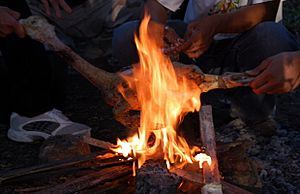Pinikpikan facts for kids
Pinikpikan is a special dish from the Cordillera region in the Philippines. It is a traditional food of the Igorot tribe, who live in the mountains.
Pinikpikan is made by gently beating a live chicken with a stick before it is cooked. This beating helps bring blood to the chicken's skin. People believe this makes the meat taste better once it is cooked. This traditional way of preparing the chicken is part of the Igorot culture. However, some people have concerns about this method.
Contents
How is Pinikpikan Made?
Pinikpikan can be prepared in two main ways: the traditional way or a more modern way. Both methods aim to create the unique flavor of the dish.
Traditional Preparation
In the traditional method, the process often starts with a prayer. This prayer asks for good things from the Igorot god, Kabunian. The live chicken is then placed down or hung by its feet. The person preparing the chicken uses a stick to gently beat its wings and neck. The goal is to bruise the chicken without breaking its skin or bones. The word "pikpik" means "to beat lightly," which is where the dish gets its name.
Once the chicken becomes still, a quick, strong hit to its head or neck ends its life. Sometimes, people check the chicken's eyes to make sure it has passed away. Next, an open flame is used to burn off the chicken's feathers. Any small feathers left are then removed by hand. In the traditional way, an Igorot elder often cuts up the chicken. They might also look at its organs to see if they predict good fortune.
Modern Preparation
In a more modern approach, chickens are bought from regular poultry sellers. These sellers can even prepare the chicken for pinikpikan for a small extra cost. The chicken is hung by its feet and briefly beaten with a stick. Then, a blowtorch is used to remove its feathers. This method is often quicker and simpler than the traditional way.
Cooking and Flavor
After preparation, the chicken is placed in a pot and boiled. Ginger is a very important ingredient for flavor. Some people like to add vegetables like chayote, pechay, celery, or watercress. People living in Benguet, a province in the Cordillera region, often add etag. Etag is a type of salted pork. However, some Igorots believe that true pinikpikan should only have chicken and ginger.
Because the chicken's feathers are burned off, pinikpikan has a special smoky taste. This unique flavor is a big part of what makes the dish so popular in the Cordillera region.
See also


